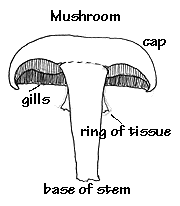Mushrooms and toadstools
As a mycologist (a botanist with an expertise in fungi), Peter Valder is often asked how to tell the difference between a mushroom and a toadstool.
All can be broadly described as the fruiting body of a fungus.
As there are thousands of different sorts of mushrooms and toadstools, it is hard to easily distinguish one from the other. There are however several pointers that can be used to decide if a fungus is a mushroom and is edible.
The widely accepted methods of being able to easily peel the cap and noticing the colour turn to silver black are not reliable indicators that a mushroom is safe to eat.
As many mushrooms are highly poisonous Peter strongly recommends not eating a mushroom that you find in a field unless you can have it positively identified.
Characteristics of true mushrooms
- There are some characteristics to look out for when determining whether a mushroom is likely to be poisonous or edible. The terms used when describing mushrooms are shown in the diagram.
True mushrooms are usually found growing in open paddocks or lawns and not under trees or shrubs like toadstools.
- The upper part of a mushroom called the ‘cap’ should be smooth and more or less white with no conspicuous raised scales or warts. Toadstools, for example the dangerous fly agaric (Amanita muscaria), will often have a different coloured cap which has scales and raised lumps on it. The fly agaric is red with white spots.
- The cap of a true mushroom pulls away from the stem as it grows leaving a ring of tissue around the stem. If you can’t find a ring of tissue around the stem, it’s not a true mushroom.
- The undersurface of the cap of a true mushroom is covered with narrow flanges called ‘gills’. In a young mushroom these are pink. As the mushroom matures they turn brown to almost black. Toadstools or poisonous mushrooms have gills that remain white throughout their entire life cycle.
- The gills of a true mushroom are attached to the cap and not to the stalk so when the stalk is removed from its base, the gills stay attached to the cap (see diagram). If the gills stay attached to the stalk then it is not a true mushroom.
- The base of the stem of a true mushroom is narrower or at least no thicker than the rest of the stalk while most of the poisonous mushrooms and toadstools have a noticeably swollen base.
Further reading
For a more detailed look at the difference between mushrooms and toadstools consult Common Australian Fungi – A Naturalist’s Guide by Tony Young (UNSW Press, 1994, rrp $19.95). ISBN 0 86840 384 9.



